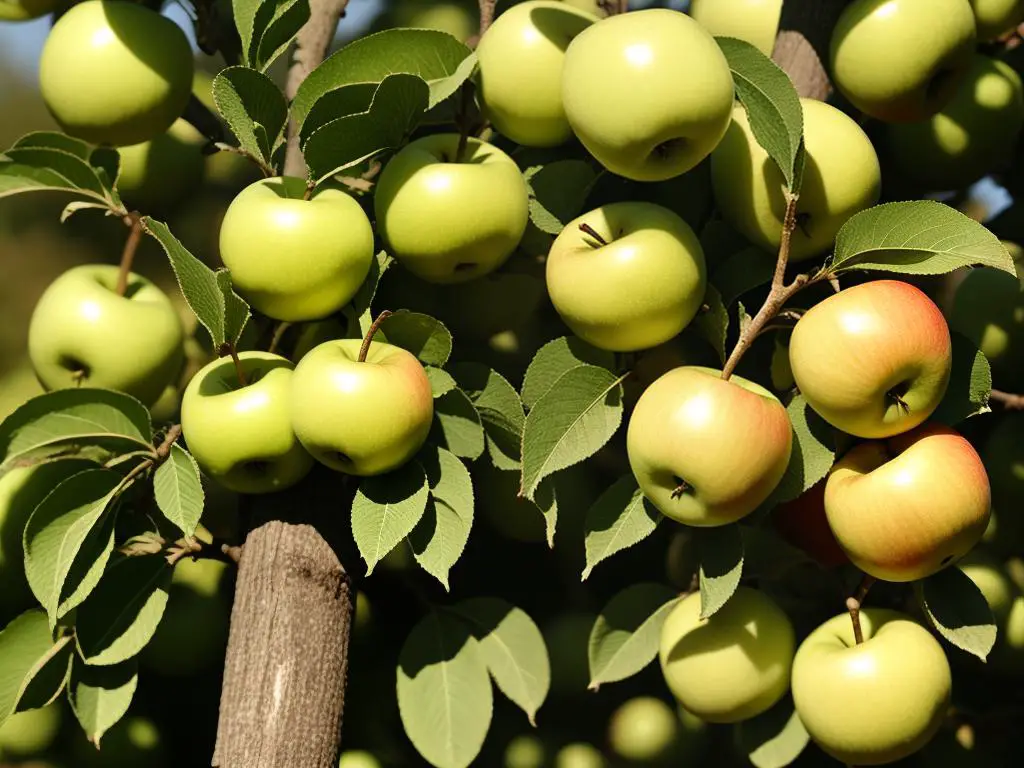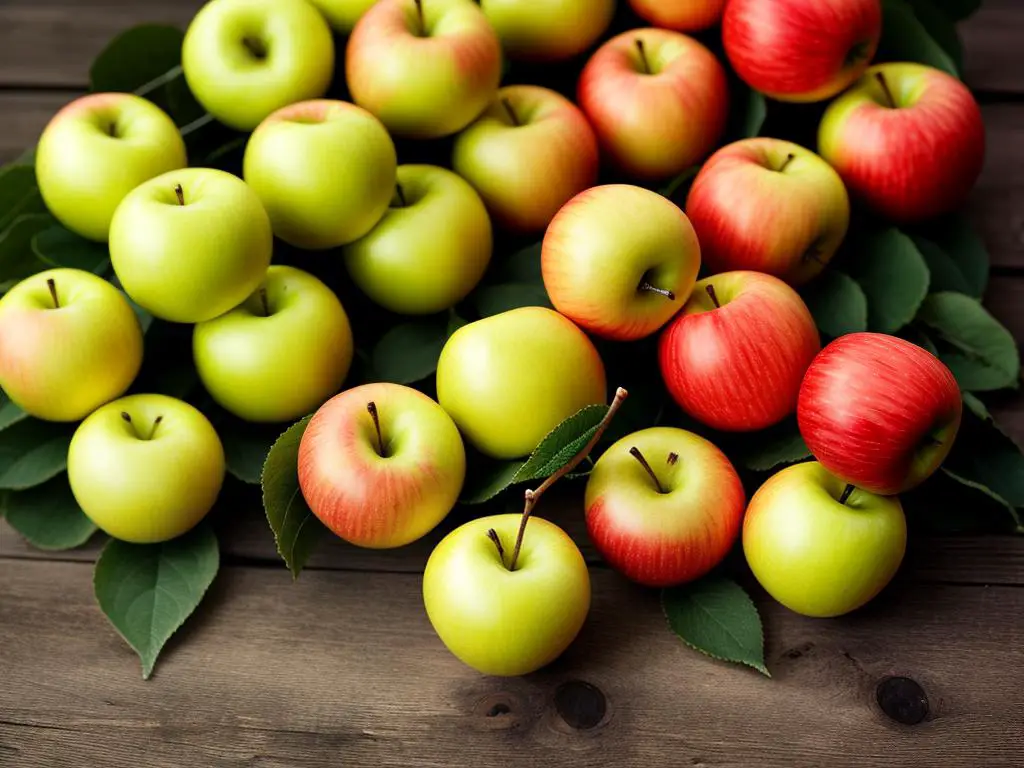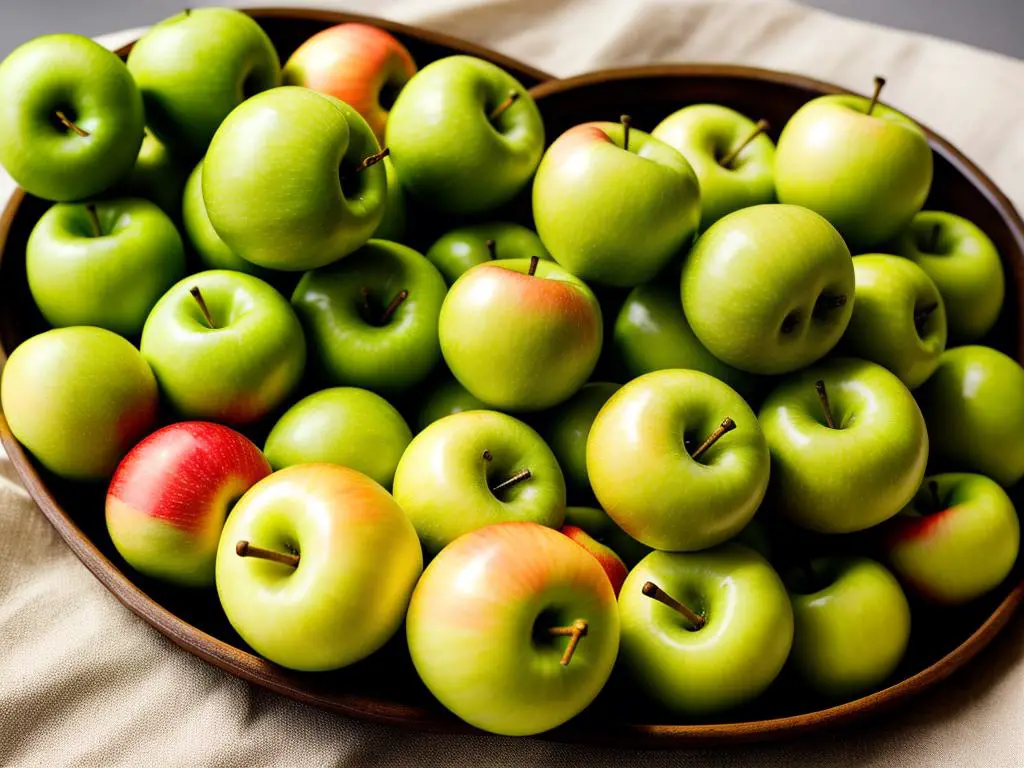In the vast world of apples, the Newtown Pippin stands as a testament to taste, history, and endurance. This unique variety of apple, known for its distinctively crisp and sweet flavor, traces its origin back to Queens, New York, and has a history as rich and captivating as its taste. This quintessentially American apple has an intriguing story to tell, one that involves notable figures, transnational journeys, and a legendary reputation. Furthermore, the Newtown Pippin apple boasts a set of unique characteristics that set it apart from the more common and commercially grown apple varieties, both in appearance and in the qualities it offers to its cultivators and consumers. Owing to its remarkable history and exceptional flavor profile, the Newtown Pippin is not merely an apple, but an experience worth exploring.
The History of Newtown Pippin Apples
Newtown Pippin Apples: A Rich History and Unique Legacy
Newtown Pippin apples have been cherished for centuries. Originating in the late 17th or early 18th century, this apple variety was discovered in the Newtown (now Elmhurst), Queens, also known as part of the former village of Newtown, in New York City. Quickly earning a reputation for its delightful flavor and crisp texture, the Newtown Pippin soon became the apple of choice among apple connoisseurs across the country.
The exact discovery date of the Newtown Pippin is disputed, but it is known that it was being sold on the market by 1730. The apple is thought to be either a chance seedling or a deliberate cross-pollination of the different apple varieties grown by early colonists. The apple quickly became a favorite of Thomas Jefferson, who considered its flavor superior to that of all other apple varieties.
Journey Across the Country: The Newtown Pippin’s Adventure
As settlers moved westward across the United States, they brought along their favorite apple variety, resulting in the Newtown Pippin reaching the Pacific coast by the early 19th century. California became a significant grower of Newtown Pippin apples, with its mild, sunny climate providing ideal growing conditions.
In 1820, Newtown Pippin apple trees were taken to Ross California as part of a mission to establish fruit agriculture, and the apples proved very successful. They soon became an essential part of the region’s economy and gained international recognition. It was also in California that the apple was renamed the “Albermarle Pippin,” a name which is still in use today.
Renowned for Taste and Texture: The Unforgettable Newtown Pippin
Noted for its unusual green color which turns yellowish when ripe, and dotted with small russet spots, it has an unmistakably unique appearance. But it’s the flavor and texture of the Newtown Pippin that truly sets it apart. Its firm, crisp flesh is both sweet and tart, with a rich and aromatic flavor that is often likened to a fine wine.
Furthermore, the Newtown Pippin’s appeal isn’t limited to eating straight from the tree. Its complex flavor profile and firm, crisp texture make this apple a top pick for both baking and cider making. In fact, the apples’ hard cider history dates back to Henry Hudson’s era, where Pippin cider was nicknamed “Hudson’s River Champagne”.
Newtown Pippin Apples in Today’s World
Currently, the historic Newtown Pippin apple variety plays an essential role in efforts to preserve native American fruit heritage. Movements led by orchards and fruit preservationists have sparked a resurgence in its cultivation and production. In fact, New York City Council even enacted a law in 2018 that officially adopted the Newtown Pippin as New York’s ‘official’ apple, a powerful symbol of the city’s local food diversity. Without a doubt, the Newtown Pippin stands as a vibrant reminder of America’s horticultural traditions dating back to colonial times.

Characteristics of the Newtown Pippin Apple
Newtown Pippin Apples: A Distinctive American Heirloom
The Newtown Pippin apple, an heirloom variety, was originally cultivated in the late 17th century in the Newtown area of Queens, what we now know as New York City. Its unique aesthetic and taste profile distinguishes it from most other apple varieties.
Recognized by its intriguing green-yellow skin, which may develop a reddish hue akin to rust, the Newtown Pippin presents an appearance distinct from any other apple. It’s easily identifiable not only by its skin but also by its retaining firmness and freshness even after lengthy storage periods.
However, what truly sets the Newtown Pippin apart is not just its unique look and texture. The apple offers a one-of-a-kind blend of sweet and tart flavors, registering as mildly acidic with an aromatic hint. It has been often compared to the flavors of pine and citrus fruits. This unconventional blend of tangy and refreshing notes makes the Newtown Pippin a favorite among those in search of a distinctive apple tasting experience.
Growing Conditions and Harvest Time
When it comes to growing conditions, the Newtown Pippin apple requires a hot and long growing season as this variety fruits late in the apple season. Originating from the east coast of the United States, it is now extensively grown across the coast due to its adaptability to various conditions. Despite its adaptability, it flourishes best in regions with a cool but sunny climate, loosely packed well-drained soil, and ample moisture.
The Newtown Pippin apple trees are typically harvested from late September to October. When harvested, the apples are usually green and will gradually ripen to their characteristic yellowish-green color. The ripening process also deepens the flavor of the apples, providing the unique taste profile the Newtown Pippin apple is known for.
Newtown Pippin Apples and Their Uses
The Newtown Pippin apple offers more than just a healthy and tasty snack. This variety is a favorite among cooks and bakers due to its distinct taste and texture. Its firm flesh holds its shape wonderfully in pies, tarts, and other baked goods, providing a unique fusion of flavors. Add it to salads or pair it with robust cheeses for a delightful culinary experience.
Moreover, the Newtown Pippin boasts a noteworthy history as one of the first American apple varieties to be exported broadly, reflecting its versatile culinary use and broad appeal. Today, it remains a treasured selection within the diverse universe of apple varieties.

The Current Status and Future Prospects of Newtown Pippin Apples
The Present-Day Presence of Newtown Pippin Apples
The Newtown Pippin apple, one of the oldest apples native to America, continues to maintain a solid if niche spot in the fruit market. This apple is distinguished by its green skin, delightful sweet-tart flavor, and crisp texture, making it a hit for baking and cider production. It has a devoted following, particularly among apple connoisseurs and specialized fruit markets.
Originally sprouting in Newtown, Queens in New York during the early 18th century, this apple was allegedly a favorite among historic figures like Thomas Jefferson and Benjamin Franklin. Its significant contribution to the apple industry is undeniable, given its role as a parent variety to several popular apple cultivars, including the Granny Smith.
Although it boasts a rich history, commercial cultivation of the Newtown Pippin apple remains relatively small-scale. Specialized plantings are scattered across the U.S., with larger growth in regions like Virginia and the West Coast, primarily Oregon and California. The apple also enjoys a certain popularity in Australia’s fruit market.
Conservation Efforts
In the wake of modern apple varieties dominating supermarket shelves, there has been an increasing effort towards heritage fruit conservation. Groups like the Slow Food USA have recognized the Newtown Pippin for its cultural significance, listing it on their “Ark of Taste” – a catalog of heritage foods in danger of extinction. They encourage small farms and nurseries to grow the Newtown Pippin to help keep the lineage alive.
Moreover, efforts have also been made at the community level, such as the “Newtown Pippin Project” in New York City public schools, which aims to promote the apple’s legacy and enhance urban biodiversity by planting these apple trees in schoolyards.
Future Prospects
Newtown Pippin Apples’ future prospects hinge on a number of factors. There’s a growing interest in heritage apples, which could invigorate the demand for the Newtown Pippin. Similarly, its unique flavor profile and potential for cider-making could attract artisan food producers and craft cider companies, leadings to a possible rise in cultivation.
Moreover, the increasing sense of consciousness towards biodiversity and food heritage could provide a boost to the cultivation of this historical apple variety and secure its place in the market and among apple enthusiasts even more firmly.
Impact on the Apple Industry
In spite of its modest presence in the market, the Newtown Pippin Apple has already proven its worth–and potential–in the apple industry. As more people seek out biodiversity and unique-tasting apples, Newtown Pippin can serve as a prime example of a heritage apple that offers something different to other common supermarket varieties.
At the same time, its parenting role in shaping newer apple breeds attests to its genetic significance. Lastly, cider producers are increasingly experimenting with a wider range of apple varieties to create unique cider experiences – a trend that could position Newtown Pippin to have a larger impact down the line.

The story of the Newtown Pippin does not end here. Its distinct taste and storied past continue to reverberate in the present, making it a desired variety both domestically and internationally. Capturing audiences with its multi-faceted characteristics and compelling history, this apple variety stands as a testament to resilience and adaptability. The Newtown Pippin, with its enduring appeal and rising popularity, will continue to play a significant role in the future of the apple industry, potentially paving the way for lesser-known apple varieties to gain recognition in a competitive market. As we look to the future, the Newtown Pippin apple will undoubtedly maintain its status as a symbol of American fruit heritage and an emblem of apple excellence.